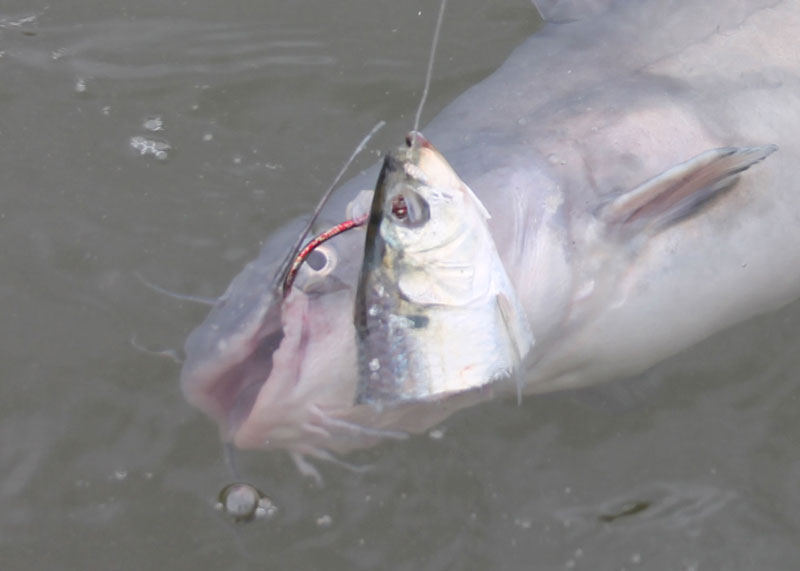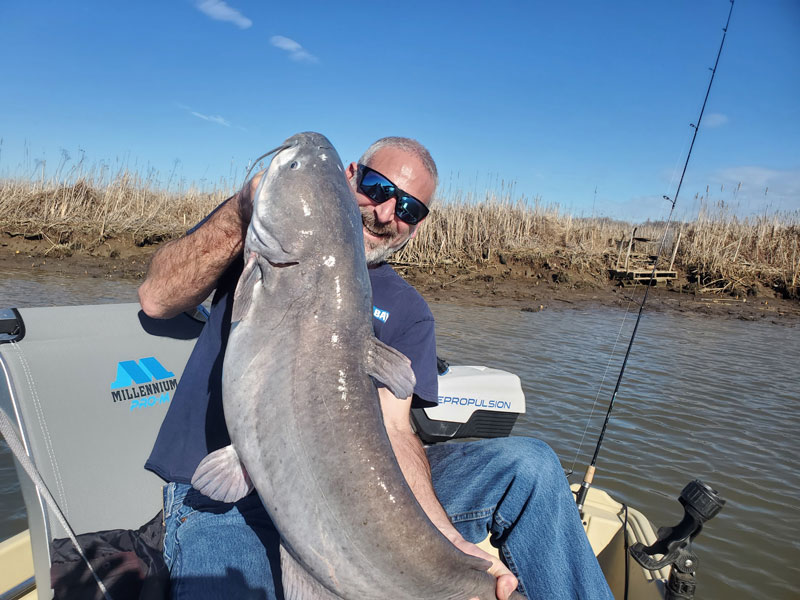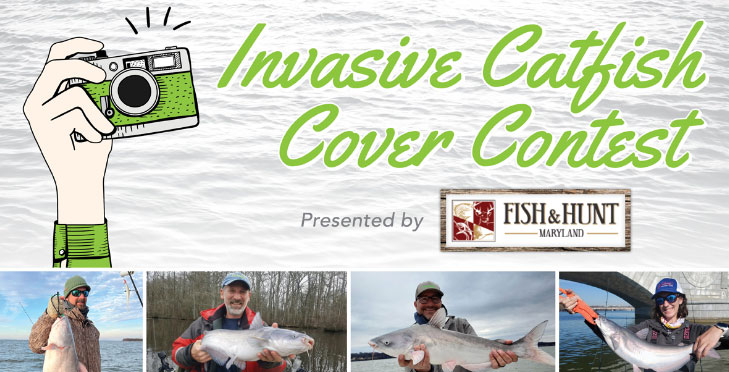
Few things set off a chain-reaction of mental imagery like the thought of catching a blue catfish of 40 pounds, 50 pounds, or more — even a new PB. And when it comes to blue catfish, we can add attaining hero-angler status since removing one of those big behemoths from the Chesapeake’s waterways means you’re saving the lives of dozens of native fish, crabs, clams, and other critters that the catfish might have eaten in the coming days.

Wait a sec – dozens of fish, crabs, and critters in mere days? Youbetcha. Blue cats eat between eight and nine percent of their body weight per day. That means that a 50-pound fish will eat around four and a half pounds of native Bay dwellers in a single 24-hour period. We’d better get out there and start reeling in these fish asap.
ISO Bluezilla
In many areas it’s easy to find blue catfish, but it’s not always so easy to locate the spots where the true giants live. Start off by looking for deep water. Blue cats will often be hanging right at channel edges or along the drop-off into a hole, and when they’re found prowling shallows it’s usually with close proximity to deeper waters.
Next, narrow your search down by looking for hard structures like deadfall or bridge pilings. It may or may not be visible depending on where you’re fishing, but you can also detect structure by where you snag. Yes, this is a curse as much as a blessing, but if casting to a certain spot results in a snagged line as often as a bite, at least you know there’s something down there. Try casting slightly off to one side or the other because that something may well be an excellent abode when looked at through the eyes of a blue catfish.
In areas with strong currents another thing blue cats love to hang out around is large rocks, the bigger the better. Again, you may or may not be able to see a boulder in the water from your vantage point. Often, however, a visible surface rip in the current will give away a boulder’s location; it may be quite subtle coming from a rock 10 or more feet beneath the surface but if you look closely while waiting for bites you can sometimes spot a tell-tale ripple that seems to always stay in the same place. Try casting your bait right behind it so the tempting morsel sits in the current’s eddy.
Meal Fit for a King

Morsel? Well, maybe not so much. Elephants might eat peanuts, but if you give them the choice between a peanut and a truckload of peanuts you know which one they’ll opt for. When using cut fish like bunker, gizzard shad, or white perch, a chunk the size of your palm is not out of line. Many anglers particularly like using the head and back of the fish. Go four or five inches back from the nose, slice the fish in half, then insert your circle hook through the baitfish’s jaws.
Another way top catfish trophy-hunters tempt river monsters into biting is by using live bait. Bluegill and white perch in the five- to seven-inch range are the most common choices. These can be lip-hooked or skewered through the back, and you won’t hurt your chances if you grab the bait knife and make a nonlethal slice or two on the fish’s side.
Finding PB Blue Catfish Hotspots
In some areas it’ll be easy to cast to a channel edge or a hole, but in some other areas not so much. So, along many shoreline hotspots you’ll want to heave-ho your offering as far out as possible to reach deep water. To give your casting distance a boost start off by choosing the longest rods you’ve got. All other factors being equal, more rod length translates into longer casts, and when bank fishing for big blue cats it’s not uncommon to see people fishing with surf rods nine, 10, or even 12 feet long. Also remember that slower action rods will cast farther than fast action rods. Since they bend farther down they can load up with more potential energy, and the tip springing back to form will help add a bit more fling to your cast.
Additional weight can help in the casting department, too. An ounce of lead might be plenty for getting the maximum casting distance out of a light rod and two ounces could be overkill. But with very large rigs you can up the ante and use two or maybe even three ounces of weight to send that lead flying for a country mile.
One final factor that comes into play when you’re trying to maximize casting distance is line choice. Thinner diameter lines will sail farther than thicker diameters, and using braid tends to give you another advantage since it doesn’t get springy and slides easily through the guides. Also remember that a full spool will cast farther than a partially filled one.

Whenever you’re casting for maximum distance from a shoreline be sure your bait is up to the task. Delicate baits like chicken liver or previously frozen bunker may tear off the hook from the force of your epic swings or the sudden deceleration of the splash-down. Choosing bait that has a bit less scent but a lot more ruggedness, like cut fresh bluegill or white perch, will be a good move.
As you decide on where you’ll fish, don't forget that the Maryland Catfish Trail details dozens of shoreline-accessible hotspots. All are open to the public, and many of these spots are ideal for family fishing with picnic areas, restrooms, and other facilities nearby. Check ‘em out at Fish and Hunt Maryland, and we’ll see you out there on the Catfish Trail!
Resource Management
The majority of the blue catfish catches you’ll make will generally consist of 18” to 32” fish, which are ideal eating size. For fish above this size range there may be public health consumption advisories in place in specific waterways. Most call for limiting the amount of fish you consume per month, so be sure to check the Maryland Department of the Environment’s online consumption advisories.
When we’re fishing in an area with consumption advisories and we catch a blue cat so big that it has more meat than can safely be consumed before it spoils, the DNR encourages us to still harvest the fish as opposed to releasing it back into the environment. That puts an eco-conscious angler in a conundrum, because we don’t want to see any fish go to waste. There is, however, a way for us to double-down on our Bay-saving angling actions: turn that fish into fertilizer. Not only will it be excellent for the plants in your garden, it also eliminates the need to buy fertilizer and spread it in areas where doing so could eventually add to the nutrient load being washed into the Bay. But you can’t just bury a 50-pound fish in your backyard — at least not unless you want every feral cat within 100 miles burrowing around in the garden. Here's how to make safe, effective fertilizer with fish that aren’t destined for the dinner table.
- Chop the fish into chunks. Smaller is better, but there’s no need to be exact about the process.
- Put the chunks, guts, and everything into a five-gallon bucket or similar container.
- Add water until you have a two-to-one ratio of water to fish.
- Add one cup of molasses (it helps jumpstart microbe growth).
- Close the container with a tight-fitting lid. Unless you want to hear about the smell from every neighbor within a three-mile radius, the tight-fitting lid is critical.
- Let the mixture emulsify for a full month.
- Remove the top and pour the liquid through a strainer to remove large bones.
- Your emulsified fish fertilizer is now ready for use. It can be diluted down at a four-to-one ratio and then used to water your plants directly.
- Just LOOK at those tomatoes!!!
Catch Catfish and WIN!
The Coastal Conservation Association Maryland’s Great Chesapeake Invasives Count continues all year, anyone can enter, it’s completely free, and you could win awesome prizes ranging from Engel coolers to Marucci sunglasses! Just sign up, then log your invasive catches including blue catfish, flathead catfish, and snakeheads, by taking a picture of them on a ruler. Every time you log a catch your name goes into a digital hat for the prize drawings. Every month five winners will be drawn and announced on Live with Lenny.
The catch information and stomach contents information we anglers provide is shared with fishery managers to help them build an understanding of where these fish are concentrated, what they’re eating, and the overall state of our fisheries. So you not only get to go fishing and win stuff, you also help the biologists figure out how to battle the invasives invasion.
Calling for Covers

You say you’d love to see yourself or your angling buddy on the cover of FishTalk Magazine? When you go for blues or flatheads be sure to take plenty of pictures, because some lucky catfish angler will end up being our November edition cover model. Pictures need to be:
- In a vertical upright format, with room at the top and bottom for the title and cover blurbs.
- High resolution and in focus.
- Showing a blue or flathead catfish caught in Maryland waters and an angler or anglers with BIG SMILES on their faces!
We’re accepting entries through September 15, so snap off some awesome cover-style photos as you enjoy catching those catfish all summer long — you never know, you might just end up on the cover of FishTalk!
Also see the other how-to/where-to articles int his series, Blue Catfish in the Bullseye Part I and Blue Catfish in the Bullseye Part II.